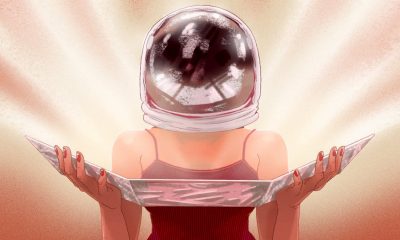Technology
If the moon is in Earth’s shadow, how can we still see it?

If the moon is in Earth’s shadow during a lunar eclipse, how can we still see it? And why does it turn red? The answer has to do with our own terrestrial sunrises and sunsets. Following is a transcript of the video.
Narrator: A blood moon lunar eclipse wasn’t always something to look forward to. When the moon turned red thousands of year ago, the ancient Mayans and Mesopotamians feared that something monstrous and evil was eating the moon. They would shout at the night sky to try and fend off the ravenous beasts. And since the average lunar eclipse lasts around 100 minutes, when the moon returns to normal afterward, they were probably convinced that their whooping and howling actually worked. We know now that the moon doesn’t need our protection. But why does it turn red in the first place?
Whenever you look up at a full moon, you’re seeing sunlight that’s reflected off the lunar surface. So if something were to block that sunlight, say the earth, then, in theory, the moon should disappear from view. But during a total lunar eclipse, when the moon passes through the earth’s shadow, we get a red moon, not a vanishing one. So what’s going on? To figure it out, let’s take a quick trip to the lunar surface.
This is a NASA simulation of what the earth looks like during a total lunar eclipse. Notice the red ring around our planet. Everywhere you see that ring is either a sunrise or a sunset. And while it’s true that no direct sunlight is reaching the lunar surface at this moment, earth’s atmosphere is bending the red wavelengths of light around the planet. So that redness you see during a blood moon eclipse is a combination of light from every sunrise and sunset on earth, all happening at once. So, the moon appears red for the same reason that sunrises and sunsets on earth are red, because of a phenomenon called Rayleigh Scattering, named after the British physicist John William Strutt, also known as Lord Rayleigh, who discovered it in the late 19th century. It describes how different colors of sunlight interact with the earth’s atmosphere.
Look at the sky during daytime, for example. It appears blue because air molecules in earth’s atmosphere scatter blue light more easily than red. But during sunrise and sunset, the light travels through more of earth’s atmosphere before reaching your eye, which has two consequences. First, it means more overall sunlight is scattered, making the sun appear dimmer. That’s why you can easily gaze upon the sun at sunset, compared to at high noon. And secondly, more scattering means more blue light is scattered away, leaving the redder wavelengths behind. Similarly, the ring around earth during a total lunar eclipse is red because the sunlight travels through a long stretch of earth’s atmosphere, from one end of the planet to the other. So, rather than fear a blood moon like the ancient Mayans and Mesopotamians, why not think of it as a romantic moment. After all, it’s the only time when you can see the sunrise and sunset simultaneously.
-

 Entertainment7 days ago
Entertainment7 days agoNASA discovered bacteria that wouldn’t die. Now it’s boosting sunscreen.
-

 Business6 days ago
Business6 days agoTesla drops prices, Meta confirms Llama 3 release, and Apple allows emulators in the App Store
-

 Business5 days ago
Business5 days agoTechCrunch Mobility: Cruise robotaxis return and Ford’s BlueCruise comes under scrutiny
-

 Entertainment6 days ago
Entertainment6 days ago‘The Sympathizer’ review: Park Chan-wook’s Vietnam War spy thriller is TV magic
-

 Business4 days ago
Business4 days agoTesla layoffs hit high performers, some departments slashed, sources say
-

 Business5 days ago
Business5 days agoMeta to close Threads in Turkey to comply with injunction prohibiting data-sharing with Instagram
-

 Entertainment4 days ago
Entertainment4 days agoChatGPT vs. Gemini: Which AI chatbot won our 5-round match?
-

 Business3 days ago
Business3 days agoFormer top SpaceX exec Tom Ochinero sets up new VC firm, filings reveal





















